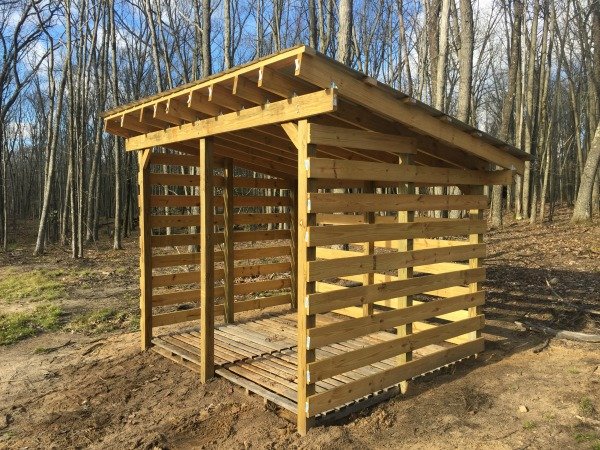Wednesday, November 6, 2024
Firewood storage shed plans for cold weather climates

Hey there, fellow fire-lovers! Winter's coming, and that means the cozy glow of a crackling fireplace is just around the corner. But before you can enjoy that warmth, you gotta make sure your firewood is ready for the cold. That's where a proper firewood storage shed comes in. It's not just about keeping your wood dry and safe, it's about keeping your fire going strong all winter long!
Now, you can buy a pre-built shed, but where's the fun in that? Building your own firewood storage shed is a rewarding project that gives you a sense of accomplishment (plus, you get to choose exactly what you want!).
Let's break down the key elements for building a firewood shed that'll stand up to the harshest winter weather:
1. Location, Location, Location:
First things first, you need to pick the perfect spot for your firewood fortress. Ideally, it should be close to your house for easy access, but also well-ventilated to prevent moisture build-up. Think about the wind direction in your area too. You don't want your shed becoming a wind tunnel that dries out your wood too quickly.
Consider these options:
Near the house: This is the most convenient, especially if you like to grab firewood on those chilly mornings before the coffee's brewed.
Against a wall: This can help to shield the shed from the wind and rain.
Under a tree: This provides natural shade and can help with drainage (just make sure the tree's roots won't interfere with the foundation).
2. Size Matters:
The size of your shed depends on how much firewood you plan to store. Remember, firewood needs to breathe and air out, so don't cram it in too tightly.
Here's a simple rule of thumb:
Small shed: If you only need to store a few cords of wood, a smaller shed (8x8 ft or 10x10 ft) will be plenty.
Medium shed: For a moderate amount of firewood (3-4 cords), aim for a shed that's 12x12 ft or 10x16 ft.
Large shed: If you're a serious firewood enthusiast and need to store a lot (5+ cords), you'll need a larger shed (12x16 ft or larger).
3. The Foundation: A Strong Start:
A solid foundation is crucial, especially in cold climates. It prevents your shed from settling, rotting, or becoming a cozy haven for critters.
Here are some options:
Concrete slab: This is the most durable and long-lasting option, but also the most expensive.
Concrete blocks: An affordable alternative to a slab, but you'll need to make sure they're leveled properly.
Wooden skids: A simple and cost-effective option, but it's important to use pressure-treated lumber and ensure the skids are raised off the ground to prevent rot.
4. Walls: Sheltering Your Firewood:
For the walls, you can choose from various materials, each with its own pros and cons:
Lumber: A classic and readily available choice, but be sure to use pressure-treated lumber for the bottom row and any areas exposed to moisture.
Plywood: Offers a more streamlined look and can be easily painted, but it might not be as durable as lumber.
Metal siding: Durable, low-maintenance, and resistant to moisture, but can get very hot in direct sunlight.
5. Roof: Keeping the Wet Stuff Out:
Choosing the right roof is key to protecting your precious firewood from rain, snow, and other wintery woes.
Shingles: A popular and relatively affordable option, but they require regular maintenance.
Metal roofing: Durable and long-lasting, but can be more expensive than shingles.
Standing-seam metal roofing: A sleek and modern look, and very durable, but also the most expensive option.
6. Ventilation: Breathing Easy:
Proper ventilation is crucial to prevent moisture buildup and mildew, which can ruin your firewood.
Here are some ventilation tips:
Vents: Install vents in the walls or roof of your shed for air circulation.
Openings: Leave small openings in the walls or roof to allow for natural air flow.
Stacking: Don't stack the wood too tightly, leaving space for air to circulate between the logs.
7. Flooring: A Solid Base for Your Firewood:
The floor of your firewood shed should be durable and able to withstand the weight of the wood, as well as any moisture that might seep in.
Concrete slab: The most durable and moisture-resistant option.
Wooden floor: A more affordable option, but be sure to use pressure-treated lumber and leave a gap between the floorboards for drainage.
Gravel floor: A simple and cost-effective solution, but it can be dusty and difficult to keep clean.
8. Finishing Touches:
Once your firewood shed is built, don't forget about the finishing touches that make it both functional and visually appealing:
Doors: Choose sturdy doors that can handle the weight of the wood.
Shelving: Add shelving inside the shed to organize smaller pieces of wood and kindling.
Painting: Give your shed a coat of paint to protect it from the elements and add a personal touch.
9. Keeping the Fire Going:
Now that you have a beautiful and functional firewood storage shed, let's talk about the actual firewood itself!
Seasoned wood: It's crucial to use seasoned wood that has been dried for at least 6 months to a year. This will ensure it burns efficiently and produces a hot, clean fire.
Stacking techniques: Stack the wood neatly to allow for proper air circulation and to prevent moisture buildup.
Covering: Cover the wood with a tarp or other protective material during periods of heavy rain or snow.
Building your own firewood storage shed is a rewarding project that will make a big difference in your winter comfort. And with the right design and construction, your firewood fortress will keep your fireplace roaring all season long!
No comments:
Post a Comment
Note: Only a member of this blog may post a comment.